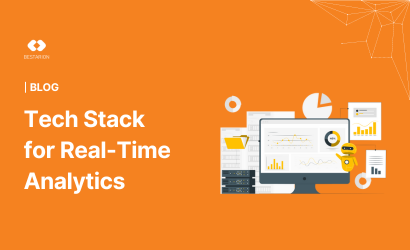The Ultimate Tech Stack for Real-Time Analytics

In today’s fast-paced digital world, businesses and organizations need to make quick and informed decisions. Real-time analytics provides the necessary tools and insights to act on data as soon as it is generated, ensuring that companies stay competitive and responsive. Building a tech stack for real-time analytics involves integrating various technologies that can process, analyze, and visualize data in real-time. This article delves into the essential components and technologies required for a robust real-time analytics tech stack.
Read more: Top 20 Most Popular Data Science Tools for 2024
What are Real-Time Analytics?

Real-time analytics refers to the process of collecting, processing, and analyzing data as it is created, with minimal delay. This capability allows organizations to respond quickly to changes, optimize operations, and improve decision-making. Unlike traditional batch processing, which involves analyzing large volumes of data at intervals, real-time analytics requires continuous processing and immediate insights.
Key Components of a Real-Time Analytics Tech Stack
1. Data Ingestion Layer
The data ingestion layer is responsible for collecting data from various sources and streaming it into the analytics system. This layer must handle high-velocity data streams and ensure low-latency ingestion.
- Apache Kafka: A distributed event streaming platform that handles real-time data feeds with high scalability and fault tolerance. Kafka will be used for ingesting data from various sources and streaming it to real-time processing systems.
- Kafka Connect: A framework for integrating Kafka with external systems, including databases, key-value stores, and file systems. Kafka Connect will be used to integrate data sources and sinks seamlessly with Kafka.
2. Real-time Data Processing Layer
The data processing layer involves stream processing frameworks that handle continuous data streams and perform complex computations in real-time.
- Apache Flink: A powerful stream-processing framework that supports event-time processing and stateful computations. Flink will process streaming data from Kafka, performing aggregations, transformations, and other complex analytics in real-time.
- Apache Spark Streaming: An extension of Apache Spark for scalable and fault-tolerant stream processing of live data streams.
- Apache Storm: A distributed real-time computation system for processing data streams with simplicity and scalability.
3. Data Storage Layer
Real-time analytics requires storage solutions that can handle high-velocity data and provide quick access for querying and analysis.
- Apache Cassandra: A distributed NoSQL database designed for handling large amounts of data across many servers with no single point of failure.
- Amazon DynamoDB: A fully managed NoSQL database service that offers fast and predictable performance with seamless scalability.
- Apache Pinot: A real-time distributed OLAP datastore designed for low-latency queries on large-scale datasets. Pinot will store processed data from Flink and provide ultra-fast querying capabilities for analytics dashboards and applications.
4. Data Query and Analysis Layer
This layer includes tools and platforms that enable users to perform ad-hoc queries, generate reports, and gain insights from the data.
- Presto: An open-source distributed SQL query engine for running interactive analytic queries against data sources of all sizes.
- Apache Drill: A distributed SQL query engine for big data that allows users to query large datasets using SQL.
- Elasticsearch: A distributed, RESTful search and analytics engine capable of handling complex queries in real-time.
5. Data Visualization Layer
Data visualization tools transform data into visual representations such as charts, graphs, and dashboards, making it easier to interpret and communicate insights.
- Tableau: A powerful data visualization tool that helps users create interactive and shareable dashboards.
- Grafana: An open-source platform for monitoring and observability, enabling users to visualize metrics and logs from various data sources.
- Power BI: A business analytics service by Microsoft that provides interactive visualizations and business intelligence capabilities.
- Apache Superset: An open-source data exploration and visualization platform that connects to various databases to create interactive dashboards. Superset will connect to Apache Pinot to create interactive dashboards and visualizations for end-users to analyze real-time data.
6. Data Management and Governance Layer
Ensuring data quality, security, and compliance is essential for real-time analytics. This layer includes tools and practices for data management, governance, and monitoring.
- Apache Atlas: A data governance and metadata management tool for managing data assets and their relationships.
- AWS Glue: A fully managed ETL (extract, transform, and load) service that makes it easy to prepare and load data for analytics.
- Apache Ranger: A framework to enable, monitor, and manage comprehensive data security across the Hadoop platform.
7. Infrastructure and Deployment Layer
Managing the deployment and scaling of applications is crucial for maintaining the performance and availability of the real-time analytics stack.
- Kubernetes: An open-source platform for automating the deployment, scaling, and management of containerized applications. Kubernetes will orchestrate the deployment of all services (Kafka, Flink, Pinot, Airflow, Superset) ensuring scalability and high availability.
- Docker: A platform for developing, shipping, and running applications in containers, ensuring consistency across different environments. Docker will containerize applications to ensure consistency across different environments.
8. Monitoring and Logging Layer
Monitoring and logging tools are essential for maintaining the health and performance of the real-time analytics system.
- Prometheus: An open-source system monitoring and alerting toolkit. Prometheus will monitor the health and performance of all services in the stack.
- Grafana: An open-source platform for monitoring and observability. Grafana will visualize metrics collected by Prometheus and provide dashboards for monitoring the system.
- Elasticsearch, Logstash, Kibana (ELK Stack): A suite of tools for centralized logging and analysis, providing search, logging, and visualization capabilities.The ELK stack will collect, store, and analyze logs from all services to troubleshoot issues and maintain observability.
8. Security and Authentication
- Apache Ranger: Provides centralized security administration for Hadoop ecosystem and other big data tools. Ranger will manage security policies and ensure data governance across the tech stack.
- OAuth 2.0 / OpenID Connect: Standard protocols for authentication and authorization. Implement OAuth 2.0 / OpenID Connect for secure access to the real-time analytics platform and its components.
Building a Real-Time Analytics Architecture
Combining the aforementioned components into a cohesive architecture requires careful planning and integration. Below is a high-level overview of how these components can be orchestrated to build a real-time analytics system.
- Data Sources: The journey begins with various data sources, such as IoT devices, application logs, social media feeds, and transactional systems, generating continuous streams of data.
- Data Ingestion: The data is ingested using tools like Apache Kafka or Amazon Kinesis, which act as the central hub for streaming data into the system.
- Stream Processing: The ingested data is then processed in real-time using frameworks like Apache Flink or Apache Spark Streaming. These tools perform operations such as filtering, aggregating, and enriching data to derive meaningful insights.
- Storage: Processed data is stored in scalable and high-performance databases like Apache Cassandra or Amazon DynamoDB, ensuring quick access for querying and analysis.
- Query and Analysis: Data analysts and scientists use tools like Presto or Elasticsearch to run queries and perform complex analyses on the stored data, generating insights in real-time.
- Visualization: Insights are visualized using platforms like Tableau or Grafana, allowing users to create dashboards and reports that provide a clear and interactive view of the data.
- Data Management: Throughout the process, data governance tools like Apache Atlas and security frameworks like Apache Ranger ensure that data is managed, secured, and compliant with regulatory requirements.
- Infrastructure Management: Kubernetes and Docker manage the deployment, scaling, and management of all services, ensuring scalability and high availability.
- Monitoring and Logging: Prometheus and the ELK stack monitor the health and performance of the system, providing alerts and logs for troubleshooting and maintenance.
Case Studies and Use Cases
Real-time analytics is being adopted across various industries to drive innovation and efficiency. Here are a few notable use cases:
- Financial Services: Real-time analytics helps financial institutions detect fraudulent activities, monitor trading patterns, and provide personalized financial advice to customers.
- Retail: Retailers use real-time data to optimize inventory management, personalize customer experiences, and run dynamic pricing strategies based on demand and supply.
- Healthcare: In healthcare, real-time analytics enables monitoring patient vitals, predicting outbreaks, and optimizing hospital operations to improve patient care.
- Manufacturing: Manufacturers leverage real-time data to monitor equipment health, predict maintenance needs, and enhance supply chain efficiency.
- Telecommunications: Telecom companies use real-time analytics to optimize network performance, detect anomalies, and enhance customer service through predictive maintenance.
Challenges and Considerations
Building and maintaining a real-time analytics tech stack comes with its own set of challenges. Here are a few key considerations:
- Scalability: Ensuring that the system can handle increasing volumes of data without compromising performance is crucial. This requires choosing scalable technologies and architectures.
- Latency: Minimizing latency at each stage of the data pipeline is essential for real-time analytics. This involves optimizing data ingestion, processing, and querying layers.
- Data Quality: Maintaining high data quality is critical for generating accurate insights. Implementing robust data validation and cleansing processes is necessary.
- Security and Compliance: Protecting sensitive data and ensuring compliance with regulations such as GDPR and CCPA is paramount. This involves implementing strong security measures and data governance practices.
- Cost Management: Real-time analytics can be resource-intensive, leading to high operational costs. Monitoring and optimizing resource usage is important for cost-effective operations.
At Bestarion, we specialize in building tailored data analytics solutions for various domains. Whether you are in finance, retail, healthcare, manufacturing, or telecommunications, our state-of-the-art technology ensures that you harness the power of real-time data to drive informed decisions. Our solutions integrate seamlessly into your existing infrastructure, providing instant insights and actionable intelligence. With our expertise, you can optimize operations, enhance customer experiences, and stay ahead of the competition. Discover the future of data analytics today. Contact us to learn how our Real-Time Analytics Solutions can transform your business!


